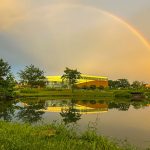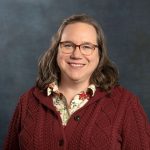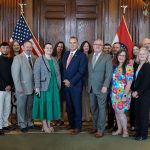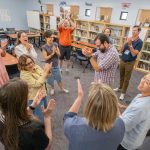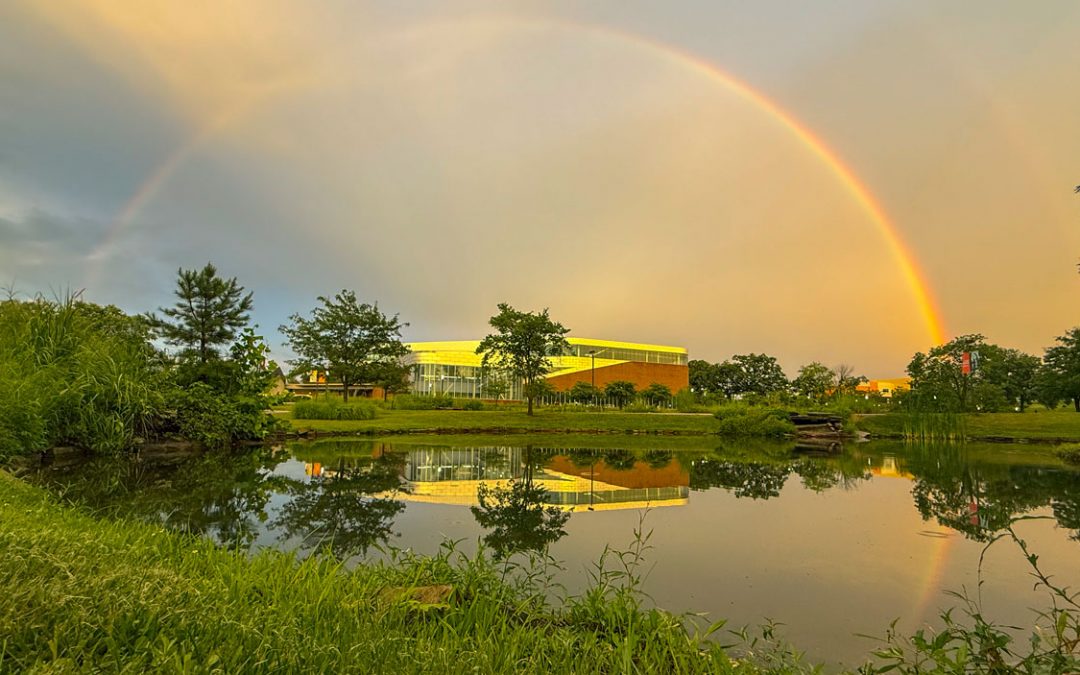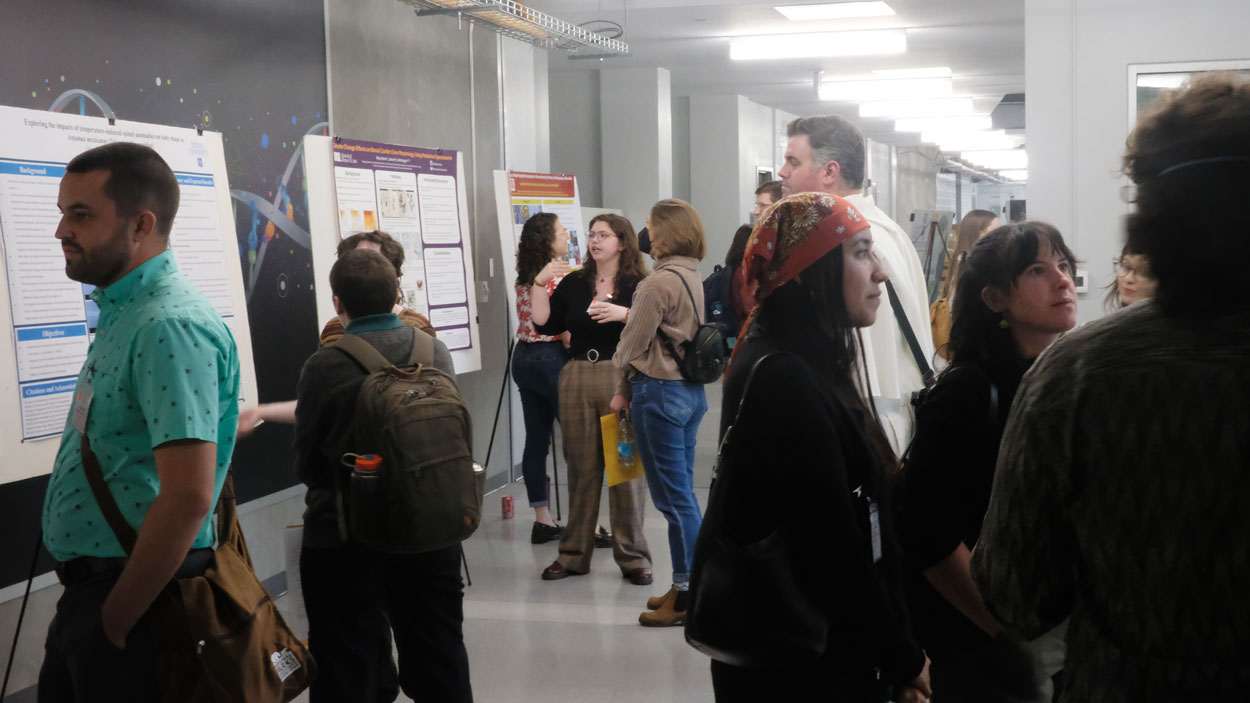
Students fill the first-floor hallway at Benton Hall as they discuss research displayed on poster presentations during the Midwest Ecology and Evolution Conference on April 26. (Photos by Steve Walentik)
The ground floor of the University of Missouri–St. Louis Science Complex, usually sleepy late on a spring Saturday afternoon, was alive with activity and conversation on April 26 as graduate biology students filled the space from Benton Hall into the lobby of the Science Learning Building.
They came from colleges and universities across the Midwest – more than 20 in total and from an area stretching from Kansas to Ohio and Arkansas to Wisconsin – all eager to share their latest research discoveries and learn about others at the 2025 Midwest Ecology and Evolution Conference.
UMSL served as host for the weekend conference, which featured oral and poster presentations in categories such as animal behavior, botany, ecosystems, entomology, evolution, genetics, pollination and population biology held over two days, April 26 and 27.
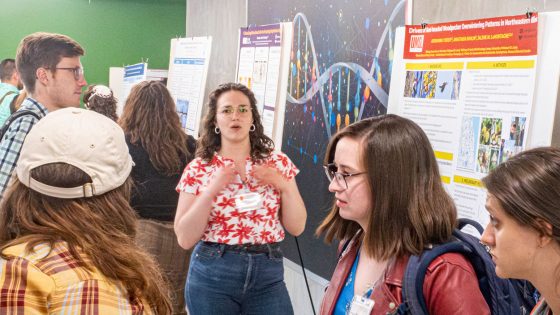
UMSL doctoral student Addy Yoder (center) chaired the committee that organized the 2025 Midwest Ecology and Evolution Conference. Yoder also shared her research on redheaded woodpeckers during the two-day conference held April 26-27 in UMSL’s Science Complex.
“It’s a unique conference because it’s an all-student run conference, and mostly students attend,” said Addy Yoder, an UMSL doctoral student who served as chair of the organizing committee. “It’s a good opportunity to kind of dip your toe in the water for conferences and just presenting in general. Everyone’s very excited to learn about your research, and they’re not expecting you to be a professional. We’re all students, so we’re all learning. I think it’s a little more accessible than doing a giant national conference.”
The conference has a history that dates to at least the late 1970s, and it’s been held nearly annually with stops at universities such as Cincinnati, Illinois, Indiana, Michigan State, Nebraska, Notre Dame and Wisconsin.
Yoder had an opportunity to attend each of the past two years, when it was held at the University of Louisville and the Southern Illinois University Edwardsville.
At the time, Yoder was in the master’s program at DePaul University, where she worked in the lab of Jalene LaMontagne. When LaMontagne accepted her position as the E. Desmond Lee Endowed Professor in Botanical Studies at UMSL last year, Yoder decided to follow here, transferring to the PhD program beginning in the fall semester.
It was near the middle of that semester that Yoder saw a message seeking an organizer and host for the next MEEC, and she immediately started giving the idea serious reflection.
“I was like, ‘Well, I’ve been the past two times, so let’s just go for it,’” she said. “I brought it up to our Biology Graduate Student Association and said, ‘Hey, I think we should do this thing.’ They we were like, ‘Yeah, let’s do it, and you can lead it and start a committee for that.’”
Casey Ernest, Soren Johnson, Raj Prasai and George Todd all signed on to help with the planning as part of that committee. They met a couple of times last fall but really started working through all the logistics to make the conference a reality in January.
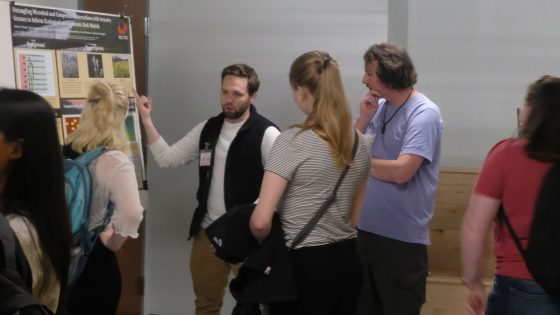
Arkansas State doctoral student Joshua Poland discusses his research on invasive species of grasses. Students from more than 20 universities across the Midwest attended the conference and shared their research.
The work included making calls to other universities seeking abstract submissions; coordinating with campus facilities for space; inviting speakers; arranging catering, field trip opportunities and a social reception held April 25 at Urban Chestnut Brewery and Biergarten; and seeking out sponsorships.
Yoder saw the conference as a chance to bring attention to the Department of Biology and the work being done there.
“I wanted to show students around the Midwest, ‘Hey, we’re doing really cool research here at UMSL, too,’” she said. “I also wanted to show off the cool collaborations we have around St. Louis. We collaborate a lot with the Saint Louis Zoo and the Missouri Botanical Garden, so it’s a cool opportunity to show off that we have all these connections and just the cool ecology research that’s happening in St. Louis in general.”
The conference featured optional field trips to the Missouri Botanical Garden, including a guided tour of the Climatron; the Saint Louis Zoo, for a look at its past and present with a focus on innovations; and Forest Park, where a nature reserve steward discussed ongoing restoration efforts.
There were plenary talks from Lisa Kelley, the executive director of the Saint Louis Zoo’s WildCare Institute, and SIUE Assistant Professor Danielle N. Lee, who earned her PhD in biology from UMSL in 2010 and is a National Geographic Explorer.
But it was the students themselves who took center stage for most of the event, with more than 40 oral presentations and more than 35 poster presentations.
Yoder was particularly pleased that 13 UMSL students signed up to showcase their research, and she presented her own work on the drivers of red-headed woodpeckers overwintering patterns in northeastern Illinois during the poster session on April 26.
“It’s been good,” Ohio State University doctoral student Jesse Wallace said. “I’ve gotten to sit through a bunch of good talks. It’s been really interesting.”
Wallace was showing off her research evaluating different methods of extracting genomic DNA from historical wet crayfish specimens.
Joshua Poland, a doctoral student at Arkansas State University, was impressed with how well organized the event was. He got to present his research on invasive species of grasses, including wild sugarcane brought to the United States after being carried in shipping containers that passed through the Panama Canal. He also enjoyed getting to pay his first visit to the Missouri Botanical Garden.
But mostly, he appreciated the interactions he got to have with other students.
“It’s a good conference because students are much more comfortable coming out and presenting some of their work,” Poland said. “It’s also a really good way to meet potential advisors or be part of potential labs where you might want to go do, let’s say, a master’s or a PhD or even a postdoc. Ultimately, it’s just a kind of a relaxed setting, and for people who haven’t gone to conferences before, it gets them really excited about presenting. I think that is extremely important, especially in today’s climate, that we get our research out there, and we get really good about explaining it to a wider audience.”


